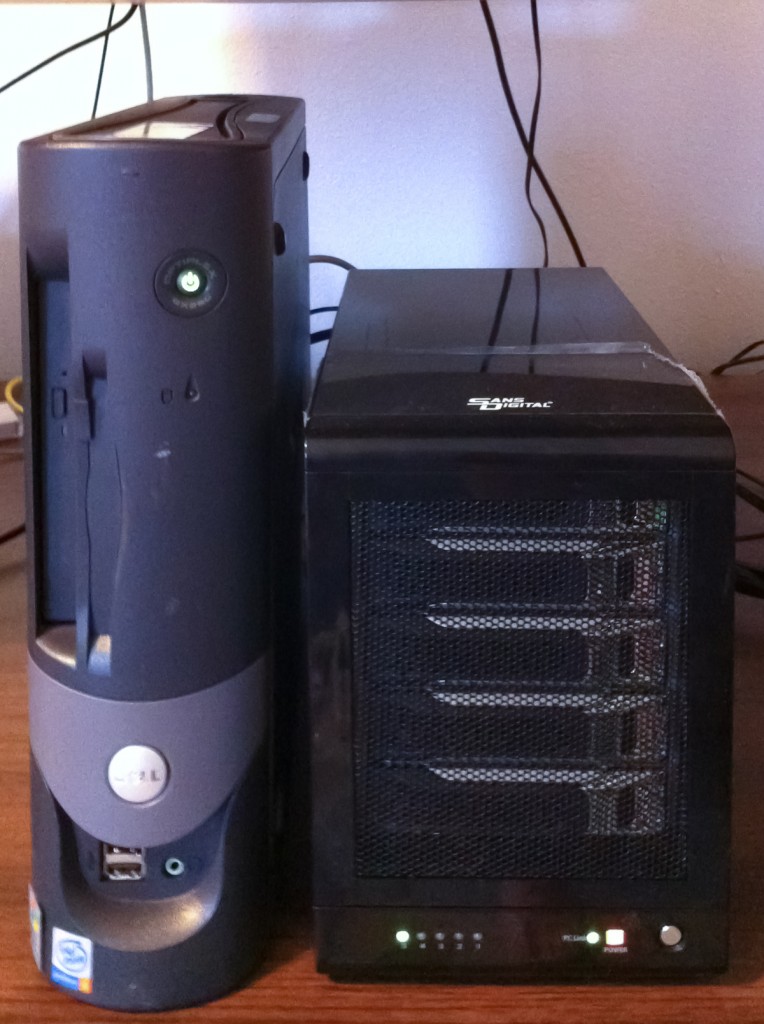All parts are here, time to do some work.
My main goal was small initial cost as well as small footprint if at all possible. I got myself old Dell GX280 desktop with P4 2.8 GHz processor and 1 GB RAM. It has “relatively” new technology onboard including one PCI Express port in which I was able to insert controller card.
The enclosure itself is highly apprised all aver the Internet Sans Digital Tower Raid that can house up to 5 drives. As you can see both are rather small and do not take too much space on/under my desk:

Now onto the setup.
As my server is supposed to serve multiple purposes, including driving my hvac system, I quickly dropped the idea of using one of dedicated NAS distributions (FreeNAS namely) and decided to stay with old mighty Ubuntu 10.04LTS. The installation went smooth and within minutes I had the server running.
But there was nowhere to find my drive inserted into external enclosure. It turns out that the controller provided by Sans Digital is built on HighPoint Technologies’ 622 chip which itself is not supported by Linux Kernel. Thankfully Sans Digital provides source codes for drivers in both RAID and passthrough versions. I’ve chosen the passthrough version as I plan to skip hardware raid provided by the enclosure and use zfs.
First some additional software needed to be installed:
sudo apt-get install dkms
Then we’ll get some sources:
wget http://dl.sansdigital.com/images/downloads/TR8M-BP_TR8MP/Non_RAID_Driver_Linux-SourceCode-v1.0-100421-1320.tar.zip
unzip Non_RAID_Driver_Linux-SourceCode-v1.0-100421-1320.tar.zip
tar -xzf rr62x-linuxla-src-v1.0-100421-1320.tar.gz
cd rr62x-linuxla-src-v1.0/
We are going to use dkms so dkms.conf file needs to be created:
vi dkms.conf
MAKE=”make -C product/rr62x/linuxla/”
CLEAN=”make -C product/rr62x/linuxla/ clean”
BUILT_MODULE_NAME=rr62x
DEST_MODULE_LOCATION=/kernel/drivers/scsi/
BUILT_MODULE_LOCATION=product/rr62x/linuxla/
PACKAGE_NAME=rr62xla
PACKAGE_VERSION=1.O
AUTOINSTALL=yes
REMAKE_INITRD=yes
Now the source neds to be moved into /usr/src folder:
sudo cp -R . /usr/src/rr62xla-1.0
And some dkms magic applied:
sudo dkms add -m rr62xla -v 1.0
sudo dkms build -m rr62xla -v 1.0
sudo dkms install -m rr62xla -v 1.0
Mere seconds later I was able to load the module:
modprobe rr62x
and see this in syslog:
[ 260.187351] rr62x: module license ‘Proprietary’ taints kernel.
[ 260.187357] Disabling lock debugging due to kernel taint
[ 260.190622] rr62x:RocketRAID 62x SATA controller driver Non-RAID v1.0 (Feb 20 2011 11:26:43)
[ 260.190678] pci 0000:01:00.0: PCI INT A -> GSI 16 (level, low) -> IRQ 16
[ 260.190689] pci 0000:01:00.0: setting latency timer to 64
[ 260.190727] rr62x:adapter at PCI 1:0:0, IRQ 16
[ 260.196263] rr62x:[0 0 ] start port.
[ 260.196263] rr62x:[0 0 ] start port hard reset (probe 1).
[ 260.196263] rr62x:[0 1 ] start port.
[ 260.196263] rr62x:[0 1 ] start port hard reset (probe 1).
[ 263.808262] rr62x:[0 1 ] start port soft reset (probe 1).
[ 264.456614] rr62x:[0 1 ] pmp attached: vendor 1095 device 3726.
[ 268.104271] rr62x:[0 0 ] failed to hard reset.
[ 268.104286] rr62x:[0 0 ] failed to perform port hard reset.
[ 269.709009] rr62x:[0 1 4] start device soft reset.
[ 270.360323] rr62x:[0 1 ] port started successfully.
[ 270.360323] rr62x:[0 1 4] device probed successfully.
[ 270.396411] scsi4 : rr62x
[ 270.399912] scsi 4:0:9:0: Direct-Access ATA SAMSUNG HD103SI 1AG0 PQ: 0 ANSI: 5
[ 270.401625] sd 4:0:9:0: Attached scsi generic sg2 type 0
[ 270.402425] sd 4:0:9:0: [sdb] 1953525168 512-byte logical blocks: (1.00 TB/931 GiB)
[ 270.402513] sd 4:0:9:0: [sdb] Write Protect is off
[ 270.402520] sd 4:0:9:0: [sdb] Mode Sense: 2f 00 00 00
[ 270.402565] sd 4:0:9:0: [sdb] Write cache: disabled, read cache: enabled, doesn’t support DPO or FUA
[ 270.402907] sdb: sdb1
[ 270.419594] sd 4:0:9:0: [sdb] Attached SCSI disk
So far so good. All pieces of hardware accounted for and work well.
Now we just have to make sure it will load the module at boot time:
sudo echo rr62x >> /etc/initramfs-tools/modules
sudo update-initramfs -u
And we are set for now.
Referrals:
1. Ubuntu forums.
